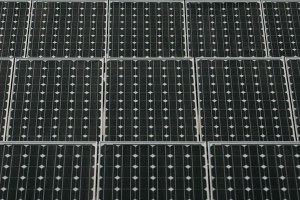
Andrew Caballero-Reynolds / Bloomberg / Getty Images
In some ways, the days are bright right now for solar power. The average price of solar modules has fallen 30% this year, continuing a steep reduction from the year before. New installations more than doubled last year, enough to make solar a $60 billion market. If you’re in the market for rooftop solar panels for your home—or just want to see solar power better compete with electricity from fossil fuels—those are all good things.
But for companies that actually manufacture solar panels, the rapid drop in prices isn’t necessarily welcome news—and for some, it might even be fatal. That’s the case for Evergreen Solar, a Massachusetts-based solar manufacturer that was forced to file for bankruptcy this week. That news came months after Evergreen—once a leader in the U.S. solar industry—announced that it would close a U.S. factory, resulting in the loss of 800 jobs.
Nor is Evergreen the only solar company to run into financial trouble recently. This week thin-film manufacturer First Solar—an industry leader and one of the country’s most valuable renewable energy firms—posted lower than expected quarterly profits, and was forced to cut its 2011 forecast, in part due to falling demand in the European market. California’s SunPower also lowered its 2011 profit forecast this week, while Australian manufacturer Silex Solar cut jobs from that country’s only plant. Meanwhile the MAC Solar Energy Index—a benchmark for global solar stocks—has lost over a third of its value over the past six months.
More from TIME: Fighting Climate Change By Not Focusing on Climate Change
From the Financial Times:
With even more raw material supply coming online in the coming months, Morgan Stanley analysts say there will likely be “further inventory build over [the second half of this year], sustained pricing pressure, and eventual capacity shut-downs and consolidation among sub-scale, higher cost players . . . it is clear that major industry consolidation still needs to take place”.
The solar industry is suffering from a sheer glut of supply at a time when demand appears to be slackening, thanks in part to the winding down of generous solar subsidies in the major European markets for modules. While European countries are still supporting renewables—Germany, in response to Fukushima, has embarked on an ambitious effort to replace nuclear power with green energy—fiscal problems and debt mean that aid won’t be indefinite. There’s hope that the American market will help pick up some of that slack, but states and cities in the U.S. may be forced to curb their own subsidies because of debt.
More from TIME: The Fading Era of Big Solar
And then there’s China. With the help of strong support from Beijing—which just announced a nationwide feed-in tariff—and the usual cheap labor costs, Chinese companies are poised to dominate the solar market, just as they have in so many other manufacturing fields. Solar panels are relatively easy to export—especially compared to bulky wind turbines—and American firms like Evergreen will struggle to compete, as GTM Research analyst Brett Prior told Reuters:
How is the U.S. going to compete in manufacturing in general when manufacturers in China have access to numerous advantages? It costs $1.10 per watt in China to make a solar panel. That same exact process costs $1.80 here in the U.S. That’s a 60 percent difference, and that’s too big.
Is the sun setting on solar? Not quite. What we’re seeing now is a rapidly expanding industry experiencing growing pains—and that’s going to mean that some firms won’t survive, and others will be swallowed up by fitter competitors. That’s not a sign of failure for the industry as a whole, even if some of the companies going out of business—like Evergreen Solar—received generous government investment. As any Silicon Valley VC will say, you need to pan through the bad ideas to get to the good ones. If we want the government to act as a VC of last resort for green startups desperate for funding—which the Department of Energy has begun to do—we need to accept the occasional cleantech Pets.com.
Video from TIME: Solar Energy Fights Poverty in Guatemala
And Evergreen’s problems went beyond competition from China and slackening demand. The company made a bet that reducing the amount of silicon in its panels would be key to cutting overall costs. That made sense when silicon prices were sky-high back in 2008, but since then silicon has fallen from $400 per kg to $55 per kg, erasing Evergreen’s competitive advantage. It was a bet that went badly—and when that happens, companies die.
As solar keeps getting cheaper—a recent Chinese report said it could be cost competitive with coal by 2015—it will keep selling. It just might be sold by fewer, bigger companies—and a lot of those companies may be Chinese. That last possibility does complicate the politics around renewable energy and especially, renewable energy subsidies. The point of government aid for solar manufacturers isn’t just to produce more solar panels and displace polluting fossil fuels. The aim is to build a new clean energy economy, as President Obama has said time and time again—and that new energy economy is supposed to include new American cleantech manufacturing jobs. And if it doesn’t, those energy policies will be harder to defend to a skeptical public.
The sun is still rising on solar. It just may be rising in the East.
More from Ecocentric: Hit “Print” For Solar Power
Bryan Walsh is a senior writer at TIME. Find him on Twitter at @bryanrwalsh. You can also continue the discussion on TIME’s Facebook page and on Twitter at @TIME


